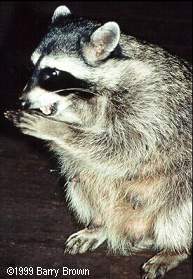

| Main/Home | What's New | Search Site | Raccoon Tales |
| Pictures & Graphics | Raccoon Facts & Info | Raccoon Problems | Diseases & Parasites |
| Raccoon Fun Pages | Causes & Links | Awards & Rings | Contact & Feedback |
 
|
Raccoon Skeleton & Anatomy
Taxonomy - Scientific classification: The common North American raccoon is the species Procyon lotor (lotor from Latin "washer"), one of seven species of raccoons in the genus Procyon, subfamily Procyoninae, of the Family Procyonidae (tail rings, 5 toes on each foot, plantigrade - walk flat footed). The Procyonidae is a member of the canoid (canine or caniform) subgroup of the Order of Carnivores. Their geologic history is old, going back to the late Eocene. Carnivores (Primarily meat-eaters, large canine teeth ) are of the Class Mammalia (Hair, warm blooded, drink milk from mother) of the Phylum Chordata, in the Kingdom of Animalia. Click on the image below to view large size picture - used with permission of University of Michigan Museum of Zoology. 
Skeleton images © University of Michigan Museum of Zoology Physical characteristics: The raccoon is easily identified by its black face mask and ringed tail. The mask helps reduce glare while aiding in camoflauge, and may enhance night vision. The tail usually has 5 to 7 complete dark rings, alternating with broader brown or gray rings, that completely encircle the tail and end in a dark tip. The tail is used as fat storage (of particular importance in the winter), and as a balance when climbing or sitting. Their pelage or fur is long and dense, a grizzled salt and pepper that varies from grayish-brown tipped with black above to light gray below although color can vary with habitat from grey to reddish brown to golden or buff. Albinistic and melanistic individuals are said to be not uncommon. Their forepaws are unusually dextrous and sensitive and resemble slendor human hands but come equipped with 20 non-retractable sharp claws. Raccoons' body length ranges from 60 to 105cm. Their tails comprise about 42% to 52% of their length. In the wild, raccoons weight ranges between 5.4 and 15.8 kg (12-35 lbs., 25 lbs. average) but varies by geographic location, habitat and season (they may lose up to 50% of their weight over winter using up their bodies' stored fat. The adult males are usually heavier than adult females.    Dentition and skull: In raccoons the normally enlarged fourth upper premolar and first lower molar (carnassial pair) of the Order Carnivora are secondarily modified. Their incisors are unspecialized, and their well developed canines are moderately long and ovate (not round) in cross section. The molars are wide and at least somewhat bunodont. Most species lack secodont carnassials. The dental formula is incisors 3/3, canines 1/1, premolars 3-4/3-4, molars 2/2-3 = 36-42 teeth. Their skulls are thick and heavy and have relatively short rostrums (shorter than canids, longer than felids). They lack alisphenoid canals, but they have well-developed paroccipital processes. Click on the images below to view large size pictures - used with permission of University of Michigan Museum of Zoology. 

Click either of above images to view larger image Skull images © University of Michigan Museum of Zoology Reproductive: Females have six mammae, arranged in three pairs in the pectoral, abdominal, and groin areas. An interesting fact from the Wittenberg University site is that the female raccoon has a bipart uterus, with two full uterine horns. Trans-uterine migration occurs in the raccoon where embryos conceived from the eggs produced in one ovary migrate to the uterine horn on the opposite side. Trans-migration allows the raccoon to support more embryos in the uterus. Ovulation in raccoons does not occur until after copulation, allowing the raccoon to conserve metabolic energy on ovulation until mating has actually occurred. Males have a well-developed, bilobed baculum (nicknamed a Coonhunter's Toothpick by the hunters that harvest them) in their penis which aids in intercourse.  . . . . . .  References/Further Resources: The Gable's Raccoon World "Raccoon Facts & FAQs (Frequenty Asked Questions)" University of Michigan Museum of Zoology's Animal Diversity Web - Procyon lotor Wittenberg University - Procyon Lotor |
![]()
![]()